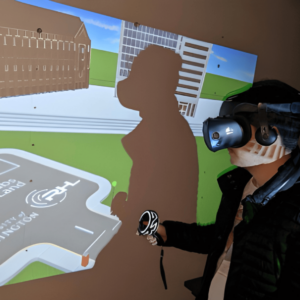 Authors:
Authors:
- Pedro Amarante, he/him, undergraduate student, Electrical & Computer Engineering, University of Washington, Seattle campus
- Rania Hussein, she/her, Associate Teaching Professor, Electrical & Computer Engineering, University of Washington, Seattle campus
Project Description
This project involves the development and implementation of a 3D Digital Twinning simulator with Virtual Reality (VR) capabilities for an embedded systems curriculum. Digital Twinning refers to the creation of a virtual counterpart for a physical entity, be it an object, system, or process. The simulator aims to enhance student engagement and learning by providing an interactive and realistic environment for understanding and applying embedded systems concepts.
Project Question
The project sought to address the challenge of integrating multiple tools and hardware components in design-oriented courses, which often consumes significant time that could be used for core learning objectives. By using a 3D Digital Twinning simulator, the project aimed to reduce the setup and configuration burden, allowing students to focus more on designing and testing their implementations. We also sought to measure the difference in learning for different types of learners and the advantage of remote access to hardware
Context
EE271 is a class that has around 100 students per quarter. It’s offered by the ECE department, it is a required class for Electrical and Computer Engineers, it is an elective for Computer Science majors . The project was also used in EE/CSE 371, which is a class that has around 80 students per quarter. It’s a class jointly offered for ECE and CSE majors, and it is required for Computer Engineers, and an elective for Electrical Engineers and Computer Science Majors. Both classes are in person.
Methods
The project utilized a 3D Digital Twinning simulator integrated with VR to simulate a parking lot. This simulator was linked to a remote FPGA lab, allowing students to design and implement control systems for managing parking spaces. This provided a more interactive learning experience.
Impact/Assessment
The impact on student learning was measured through an anonymous survey focusing on the simulator’s usability, intuitiveness, and educational value. Preliminary findings indicated significant improvement in student engagement, comprehension, and performance. The survey used Likert Scale responses, multiple choice/select questions, and open-ended queries, targeting the simulator’s interface, effectiveness in aiding lab task understanding, and equitable features.
92 students were offered the survey, with a response rate of 81.5%. The first question identified their learning style, with 47% visual, suggesting the efficacy of visual aids and 3D simulations in teaching. Understanding the students’ preferred learning styles was crucial to evaluating the effectiveness of the 3D Parking Lot Simulator tool used for students’ projects, and allows us to identify the most effective ways of incorporating the tool to enhance student learning outcomes. The survey results showed a preference for the 3D Parking Lot Simulator over traditional methods for interfacing with lab inputs and interactions.
Students were asked to compare the 3D simulation with traditional switches and LEDs for lab tasks. 52% said using traditional methods would be slower, and 37% felt it would take twice as long. The findings highlight the strength of virtual hardware, with many agreeing on the convenience of accessing the simulator anywhere, supporting the trend towards remote and blended learning environments.
Application
Instructors in other disciplines can learn from the project’s approach to integrating immersive and interactive simulations in teaching complex concepts. The findings can be applied to various instructional contexts, emphasizing the use of digital twining and VR to enhance student engagement. This can be useful for multiple fields, as it is a tangible way to measure the impact of the usage of virtual reality as an educational tool. The study also describes how different types of learners interacted with our project. This knowledge is useful in providing a deeper understanding on how different types of people approach learning.